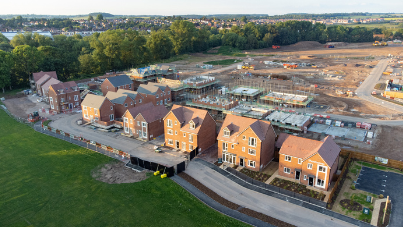The Court of Appeal has confirmed the legality of Natural England’s technical guidance to local planning authorities on nutrient neutrality (“Guidance“) in a judgement handed down on 15 July.
Mr Wyatt is the Chairperson of a local residents group which is opposed to the development and he judicially reviewed Fareham Borough Council’s (“Council“) decision to grant planning permission. That application for judicial review failed on all fronts but Mr Wyatt obtained permission to appeal that decision and it was this appeal which was considered by the Court of Appeal.
Given their vested interest Natural England joined the party and made submissions as did the landowners of the proposed development site.
The case concerns a planning application for an eight unit development in the catchment area of the Solent and Southampton Water Special Protection Area (“SPA“).
The Council, as part of the planning process, was required by regulation 63 of the Conservation of Habitats and Species Regulations 2017 (“Habitats Regulations“) to undertake an “appropriate assessment” to ensure that the development would not adversely affect the integrity of the SPA.
Regard was had to the Guidance and a nutrient neutrality budget calculation was carried out. For an explanation of those calculations please see our article.
The case law considered by the Court of Appeal makes it clear that the role of the court is to satisfy itself that the assessment carried out by the Council was lawful and not to undertake an assessment of its own. It is also appropriate for the Council to give significant weight to the advice of an “expert national agency” such as Natural England.
The Habitats Regulations embody the precautionary principle which requires a high standard of investigation but that does not need to establish an absolute certainty of no adverse effects on the SPA. The test is that the Council must be satisfied that there is no reasonable doubt as to the absence of adverse effects on the integrity of the site concerned. The assessment, using the best scientific knowledge in the field is subjective in nature and the issue ultimately rests on the judgment of the Council.
Guidance
The Guidance advocates the calculation of a nutrient budget which calculates the levels of nutrients produced by a development and compares those to the levels generated by the existing lawful use of the site.
The nutrient loss from the existing use is modelled using standard figures (Farmscoper model) for different types of land use such as agricultural, woodland and green space considering the history of the site over the last 10 years.
If this calculation results in a positive figure then some form of mitigation is required to avoid increased levels of nutrients in the SPA and the associated problems of algal blooms etc.
In calculating the nutrient output of a development an average national occupancy rate of dwellings of 2.4 persons was used along with maximum daily water usage of 110 litres per person. A 20% precautionary buffer is then applied.
Since the High Court decision referred to above, Natural England have revised the Guidance but those changes do not impact on the issues before the Court of Appeal.
Mr Wyatt objected to the use of the average national occupancy rate on the basis that the proposed development was of large detatched houses with four or five bedrooms. He also argued that the 20% buffer was an arbitrary figure with no evidential basis.
High Court
The judge was critical of the use of the 2.4 person occupancy rate but did not think it sufficiently unreasonable and that it was in line with the precautionary principle. The reasoning was that there is not a directly proportional link between occupancy and water consumption. Also, the algorithm assumes that the occupants are all inwards migrants to the area and not moving within the locality. The use of the 20% precautionary buffer did not justify judicial intervention as there was room for debate between reasonable scientists.
Court of Appeal
In the leading judgment given by Sir Keith Lindblom, the Senior President of Tribunals, the Court had to determine two questions as to whether the Council had:
- Failed to comply with the Habitats Regulations; and
- Complied with its duty under section 38 (6) of the Planning and Compulsory Purchase Act 2004.
Habitats Regulations
Mr Wyatt criticised the judge for accepting the expert evidence from Natural England and argued that the failing status of the SPA meant that a greater degree of certainty was required. The uncertain data meant that the approach should have been that of the “reasonable worst case scenario” which is the approach taken in environmental impact assessments.
The standard occupancy rate was attacked once again and it was argued that the Council should have adopted a bespoke calculation so as to be in accordance with the precautionary principle and based on the best available evidence.
It was also argued that the average figures for agricultural and other land uses were inappropriate as they relied on speculation about future land use and so did not provide the certainty required under regulation 63.
The arbitrary nature of the 20% precautionary buffer was the next target with the main points being that it lacked any evidential basis and could only be sensibly quantified once the inherent uncertainty of the scheme had been calculated.
The court rejected these arguments ruling that the Council had reached an evaluative judgement and the judge had assessed the expert evidence with care. The unfavourable status of the SPA was already acknowledged by the Guidance which the Council relied upon. The judge did not fail to apply the precautionary principle and did not have to assess the “reasonable worst case scenario.” Further, it was open to the Council to rely on the precautionary effect of several factors in the nutrient budget which combined to make the occupancy rate selection acceptable. The reasons aired in the High Court that there is not a directly proportional link between occupancy and water consumption and the algorithm assuming that the occupants are all inwards migrants to the area being cases in point.
The court said that there is no objection in principle to using standard land use figures and the appropriateness of doing so was a matter of judgement for the Council.
On dealing with the buffer figure of 20% the decision was that it does not lack the necessary certainty merely because it is the product of an exercise of judgment as opposed to an arithmetical calculation.
Planning and Compulsory Purchase Act 2004
Section 38 (6) of the 2004 Act requires a planning application to be determined in accordance with the development plan unless material considerations indicate otherwise. The second question to be determined by the court was whether the Council had complied with this requirement.
Broadly the Council had acknowledged that it did not meet the five year housing supply test and that as such development outside defined settlements would be acceptable. The Court accepted that the Council was entitled to conclude that the proposed development was in accordance with the development plan as a whole. That was a matter of judgment when considering two planning policies which pulled in different directions.
Lord Justice Males dissented from the leading judgment on the single issue of the occupancy rate. His view was that the Council’s assessment was not in accordance with the Guidance but the process was lawful because there was a good reason not to follow that procedure.
The reasoning was that the average occupancy rate of 2.4 represents a starting point only and not a mandatory recommendation. Also, for the development in question it was easy to obtain an average occupancy rate for four bedroomed houses (3.14 persons per dwelling) from the same 2011 Census.
The Council also then erred in assuming that the use of the 2.4 average figure was already sufficiently precautionary because it assumes that every occupant of every new dwelling is a new resident of the area. That, the judge determined, is not what the Guidance says.
Also, the Council then mistakenly took the view that the application of the 20% precautionary buffer helps ameliorate the effect of underestimating the total population of the development. Again, this is not a correct application of the methodology. The precautionary buffer is not a substitute for using the best available evidence based occupancy rate. It is an additional protection to be applied after the evidence has been gathered for the nutrient budget and that process has been completed.
However, the question for the Council was not whether it had followed the Guidance methodology but whether it had carried out a sufficient “appropriate assessment” for the purposes of the Habitats Regulations. The Guidance is not mandatory and Natural England said they had no concerns which was a view the Council was entitled to have regard. That was a good reason for departing from the Guidance methodology and so the assessment was lawful.
As a postscript, Males LJ points out that the 2022 updated guidance from Natural England recognises that the average occupancy rate of 2.4 may not be appropriate for certain types of development.
Michelmores Property Development Club
The Michelmores Property Development Club (PDC) is a forum for developers and property professionals to connect and share knowledge. The Club is celebrating its 22nd...
Michelmores Property Awards
Celebrating the best of property, development and construction in the South West The Michelmores Property Awards celebrate the best property, development and construction projects in...



